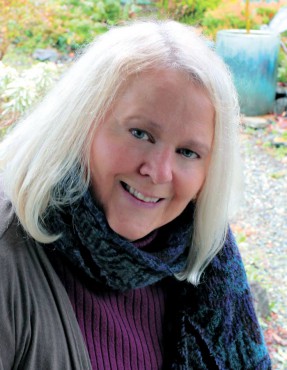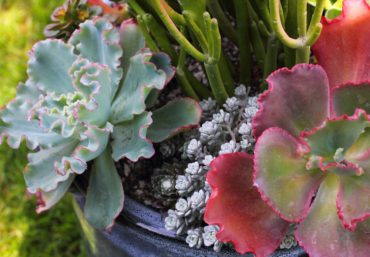
Between the cracks of the dark basalt rocks, sedum’s plump rosettes cascade, a cavalcade wash in waterfall gray.
Many succulents in the Sedum genus grow around the world. Gardeners love them because they are fascinating plants. Sedum spathulifolium species evolved to grow in difficult places in the Northwest — their water storage capabilities help them thrive when water is scarce.
For those living on the west side of the Cascade Mountains, a succulent plant with a need to store water seems a contradiction to the rainy climate. For sure, the native sedums deplore wet soil, yet place them in full sun on a dry cliff; in a crevice; or in sandy, gravelly or rocky soil, and the native sedums flourish where other plants dare not grow. The rosettes can root and cling to bare rock if need be. They grow in these areas free of competition from other plants.
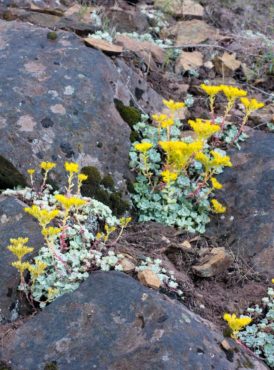
According to the U.S. Department of Agriculture’s map of native plants, Sedum spathulifolium ranges from California to British Columbia coastal areas. These natives grow at sea level and as high as 5,200 feet in the Sierra Nevada Mountains and Klamath Mountains, where the leaves grow larger.
Locally, they grow at the south end of the Kitsap Peninsula. Also found in Port Angeles, the succulent grows in crevices on south-facing slopes and on cliffs near the beach on the north side of Crescent Lake and in the foothills above Sequim. The most interesting location is on a mossy rock in a river channel on the Cedar River in North Bend, Washington.
Evergreen leaves grow in a spiraling, tight rosette. Creeping stems help the succulents colonize an area. However, they are not thugs. Once they’re introduced to your garden, you may wonder why you never utilized them before.
In the Northwest, this sedum is a ground-covering wonder. These low-to-the-ground perennials serve a useful purpose in the rock garden — tucked into rock walls and crevices or left to fend for themselves on dry ground. For beginners, sedums grow with ease in well-drained soil. The plants form a dense, textural carpet of trouble-free rosettes.
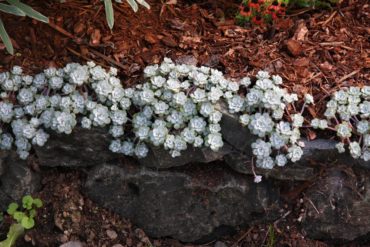
This plant was known to the Makah tribe as the water plant tcatca’ ‘kikI because of its fleshy leaves. They turned to eating the fleshy sedum leaves if they suspected malicious spirits tainted their water. Other indigenous people used the plant as a medicinal for a variety of maladies, such as a decoction for constipation or a wash for soothing nervous babies.
Edible Sedum
The succulent foliage is used in soups or even as a stir-fry. To serve this to your family or guests would get everyone talking about the strange new vegetable on the table, hopefully without an “ew” comment.
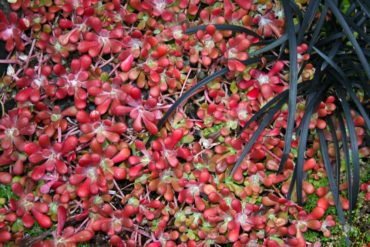
If you choose to add the leaves to your diet, harvest in the morning before the CAM (crassulacean acid metabolism) processing of CO2 builds acid content in the foliage. This process adds an acid/peppery taste that by afternoon or evening makes the sedums unpalatable. Caution: Eating too many of them can cause an upset stomach.
Cultivate
These sedums take a light, well-drained soil in full sun. The plants are adapted to growing in rock walls and crevices, and thrive in rocky soils. They are stress-free plants to grow and for a beginning gardener, this is good for a successful garden experience.
Sedums are easy to propagate and increase stock using stem cuttings or divisions. Gently pull a rosette away from the plant and lay it on open soil anywhere you want it to grow. It will root and colonize an area in little time.
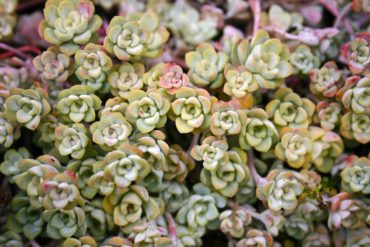
Cultivars
Choosing one sedum is hard to do when there are so many to appreciate. Sometimes gardeners do not value the native plants as much as other regions of the world. England’s Royal Horticultural Society bestowed Sedum spathulifolium ‘Cape Blanco’ with the Award of Garden Merit. Named after the place where it grows in Cape Blanco, Oregon, this native sedum is one of the most popular stonecrops cultivated in gardens around the world.
Being a Northwest native makes it a perfect choice for this maritime climate. A silvery-white, waxy powder covers the handsome rosettes of fleshy, green leaves, giving the plant a silvery-white appearance. It colonizes as a dense, white carpet of fleshy leaves.
With outstanding foliage, the yellow flowers seem like an afterthought. When the flowers put on their annual show, they smother their rosettes with bright, mustard-yellow blossoms on short racemes. As soon as the flowers fade, deadhead the flowering stems so the foliage comes to the forefront.
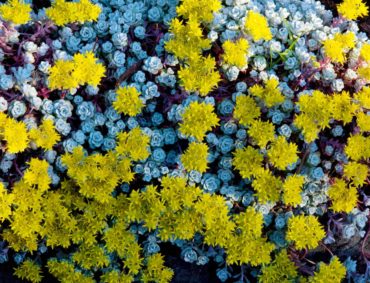
You can appreciate Sedum ‘Cape Blanco’ growing in nooks and crannies along rock walls and edges of pavers (where there is little to no foot traffic). This variety is a standout cascading down dark basalt stone that shows off the perennial’s attractive, silver-gray foliage.
Another one of note is S. spathulifolium subspecies purpureum, which is a sport of S. ‘Cape Blanco.’ The deep purple in the leaves shines through the white, powdery coating. When the sports are removed from the parent plant, they do not revert. Similar to this, but with medium-sized rosettes, are Sedum spathulifolium subsp. pruinosum ‘Carnea,’ with a brighter red hue, and ‘William Pascoe,’ with a more purple-red hue.
Add any of these to the garden for an eye-catching carpet of texture and color.




